India
Night of the Kittika Festival
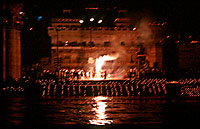 Folks were working feverishly on the Assi
Ghat, painting the step, laying out candles
for the night's festivities. I notice
many westerners going to the boats and
guess that that's where the action will
be. So I load up on 400 speed film, and
run into Ron and Heidi, my neighbors
from Larkspur, and we hit it off right
away. Ron is a psychologist (aha!) and
he and Heidi are on a 3 month honeymoon
touring Asia. So we do some bargaining
with a boat boy and get a boat for 600
rupees ($15) to view the wild activities
of the ghats from the river.
Folks were working feverishly on the Assi
Ghat, painting the step, laying out candles
for the night's festivities. I notice
many westerners going to the boats and
guess that that's where the action will
be. So I load up on 400 speed film, and
run into Ron and Heidi, my neighbors
from Larkspur, and we hit it off right
away. Ron is a psychologist (aha!) and
he and Heidi are on a 3 month honeymoon
touring Asia. So we do some bargaining
with a boat boy and get a boat for 600
rupees ($15) to view the wild activities
of the ghats from the river.
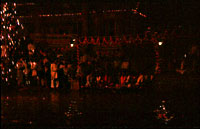 And we weren't disappointed. Each ghat
was beautifully lit up with candles laid
out in perfect fashion on tha ghat step.
Music everywhere, dancing, fireworks,
tacky neon lights, plays, every kind
of good, clean Hindu fun you can imagine.
Across the river, in the sand is a huge
array of a thousand candles lighting up
the east bank. Most impressive. We had a
blast going up and down the river, and my
inner boy was as delighted as a trip
to Disneyland.
And we weren't disappointed. Each ghat
was beautifully lit up with candles laid
out in perfect fashion on tha ghat step.
Music everywhere, dancing, fireworks,
tacky neon lights, plays, every kind
of good, clean Hindu fun you can imagine.
Across the river, in the sand is a huge
array of a thousand candles lighting up
the east bank. Most impressive. We had a
blast going up and down the river, and my
inner boy was as delighted as a trip
to Disneyland.
Returning to the Assi Ghat, the floor was laid out with candles in all sorts of formations, really beautiful light work, with an Om Namah Shivaya bhajan blasting over the loudspeaker. Damn, did I pick the right time to come to Varanasi!! What a party.
 Dinner as usual was at 8:30, and I
meet Arlene, a professor of Asian
Studies at Stanford on a sabbatical.
She has quite a karmic connection
and history with India, and we
speak for over 90 minutes on all
sorts of subject. She was one of
Satya Sai Baba's first western devotees
25 years ago, and calls him her
"maha-guru". She's been around the
block, and she has recently been
working with several Buddhist teachers.
She notes the lack of understanding
of the spiritual process in many
western folks, and we discuss the
necessity of preparation of our
inner channels for the kind of
intense energies that more advanced
teaching can hit you with. This was
so refreshing for me to hear, someone
who has found and understood some
previously rare teachings on spiritual
stages. She is also a pretty good
"Jyotish" (Vedic Astrologer) and we
discuss that whole scene.
Dinner as usual was at 8:30, and I
meet Arlene, a professor of Asian
Studies at Stanford on a sabbatical.
She has quite a karmic connection
and history with India, and we
speak for over 90 minutes on all
sorts of subject. She was one of
Satya Sai Baba's first western devotees
25 years ago, and calls him her
"maha-guru". She's been around the
block, and she has recently been
working with several Buddhist teachers.
She notes the lack of understanding
of the spiritual process in many
western folks, and we discuss the
necessity of preparation of our
inner channels for the kind of
intense energies that more advanced
teaching can hit you with. This was
so refreshing for me to hear, someone
who has found and understood some
previously rare teachings on spiritual
stages. She is also a pretty good
"Jyotish" (Vedic Astrologer) and we
discuss that whole scene.
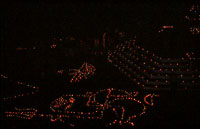 She advises
me on what to see in South India, and
again another jewel of information
for helping out with planning. Based
on what she tells me about Satya
Sai Baba, I am surprised that
what he is known for, miracles and such,
is not the core of his teaching, which
is Advaita Vedanta (non-dualism). As
Johnny Carson says,"Didn't know that!".
And since his ashram near Bangalore is
on the way to Ramana's ashram, I just
may go to see him. But we'll see how
that part of the trip unfolds.
She advises
me on what to see in South India, and
again another jewel of information
for helping out with planning. Based
on what she tells me about Satya
Sai Baba, I am surprised that
what he is known for, miracles and such,
is not the core of his teaching, which
is Advaita Vedanta (non-dualism). As
Johnny Carson says,"Didn't know that!".
And since his ashram near Bangalore is
on the way to Ramana's ashram, I just
may go to see him. But we'll see how
that part of the trip unfolds.
November 5th
Feel a little sick in the morning, and change hotels, since Ganges View, which is quite the popular place, is all booked up. So I move next door to the Sahi Guest house, a simple, spartan, but clean guest house with a nice verandah overlooking the Ganges. I feel good that I can use this as a base for further exploration of Varanasi. I am now really settled in here in Varanasi, and feel like I am in retreat mode.
I visited several temples during the day, and some of them are off limits to non-Hindus - some Hindus believe that since we have not had the same sacraments that all Hindus have growing up, our western bodies are more impure and therefore not allowed into some of the more sacred site. But when this occurs, a balcony is provided for people to view the shrine from a distance. I am not bothered too much by this, and feel uplifted from the blessing of each temple.
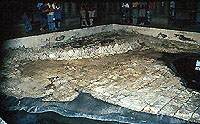 One strange temple is the Bharat Mandir,
which contains a giant, extremely acccurate
marble map of India as its central icon,
opened by Mahatma Ghandi. I like maps,
but a map temple?
One strange temple is the Bharat Mandir,
which contains a giant, extremely acccurate
marble map of India as its central icon,
opened by Mahatma Ghandi. I like maps,
but a map temple?
November 6, Varanasi Days
Hot and humid day today, just like all the other days, but apparently the locals say that this is unseasonably warm. I only could imagine what it's like when it's 117 degrees outside.
I've just settled, or melted into the landscape, now really in India or retreat speed - one errand, one entire day, that kind of thing.
Went on a pre-dawn boat ride with Arlene this morning. She had to bang on my hotel door, as both my alarm clocks didn't go off. And being a long and experienced India traveller, I just kept my mouth shut and watched and learned as she dealt with negotiations with the boat boy, who kept lowering his price.
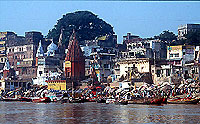 In contrast to my first
day on the river Ganges, this was a very
different experience -there was a slow,
surreal "heat and dust" quality to the
entire ride, and my body/mind, like a
tuning fork, fell into sway with the
impersonal, but blissful energy that
presented itself on the river this
morning, to the point I was swooning.
Didn't need to formally meditate, that
was the morning meditation, a thoughtless
blissful condition not disturbed by
any sensual input - it just was another
player in the whole show, whole effect.
In contrast to my first
day on the river Ganges, this was a very
different experience -there was a slow,
surreal "heat and dust" quality to the
entire ride, and my body/mind, like a
tuning fork, fell into sway with the
impersonal, but blissful energy that
presented itself on the river this
morning, to the point I was swooning.
Didn't need to formally meditate, that
was the morning meditation, a thoughtless
blissful condition not disturbed by
any sensual input - it just was another
player in the whole show, whole effect.
I changed back to the hotel Ganges View, as it seems to be a real home base, and the food is fabulous. Can't say enough good things about this place, though the Sahi Guest House was fine also. The Hotel Temple on the Ganges, down the block, looks like an excellent place also. The top story rooms with attached bath facing the Ganges were only 450 rupees, about $11 a night.
Did a lot of doing nothing today, just
sat around on the Assi Ghat and watched
the sadhus, cows, dogs, kids, beggars,
boats and mungphali (peanut) vendors for
hours. Much of the time the utter simplicity
of non-dual/not-two existence presented
itself in a stark Obviousness.
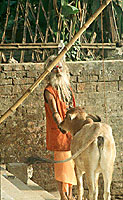 This area,
the ghat area around Varanasi, it truly
Shiva's Palace, the quality/ies associated
with Shiva abound here, but if you're
involved with mind or some issue, you
can miss this loud and blatant Open Secret.
The teeming activity are just the waving
arms of the Goddess that is a veneer of
the presence and force and "Isness" of
Shiva, the force of Consciousness, radiant
yet unmoving, as it is not "in" a context
to move, it is the context in which
movement takes place. And the awareness
of that context is not a separate function,
activity or "entity" from anything observed,
from the View of the Open Secret.
This area,
the ghat area around Varanasi, it truly
Shiva's Palace, the quality/ies associated
with Shiva abound here, but if you're
involved with mind or some issue, you
can miss this loud and blatant Open Secret.
The teeming activity are just the waving
arms of the Goddess that is a veneer of
the presence and force and "Isness" of
Shiva, the force of Consciousness, radiant
yet unmoving, as it is not "in" a context
to move, it is the context in which
movement takes place. And the awareness
of that context is not a separate function,
activity or "entity" from anything observed,
from the View of the Open Secret.
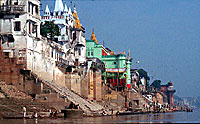 So basically, the forced slow pace of India
is a tool in which spiritual revelation is
made more possible. Of course, a slow pace
is just one ingredient, there are many other
hot, slow places on earth, but this place,
with the combination of empowered geography
and empowered man-made temples, makes the
possibility of revelation all the more likely.
So basically, the forced slow pace of India
is a tool in which spiritual revelation is
made more possible. Of course, a slow pace
is just one ingredient, there are many other
hot, slow places on earth, but this place,
with the combination of empowered geography
and empowered man-made temples, makes the
possibility of revelation all the more likely.
Perhaps that is why so much "lip-service" spirituality goes on India, people can ride on the fullness of the "force"-field that is here. But if you're in Buffalo, Cleveland or Barstow, you don't have such luxury. But there is also sincere devotion going on all over the place here, not saying that real-work isn't being done.
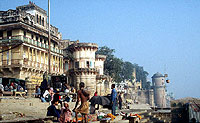 So in the meantime, while doing nothing, I
practice my Indian head-nod, a particular
and curious gesture that all Indians perform,
as if one is snapping one's neck slowly, and
which has many meanings, such as yes, no,
I don't know, this confuses me, maybe, and
perhaps most of all, whatever, all based
on context. It is contagious - I find myself
doing it in conversation with westerners now.
Pretty soon I'll be addicted to cricket,
the national obsession. Man, what a dumb sport!
So in the meantime, while doing nothing, I
practice my Indian head-nod, a particular
and curious gesture that all Indians perform,
as if one is snapping one's neck slowly, and
which has many meanings, such as yes, no,
I don't know, this confuses me, maybe, and
perhaps most of all, whatever, all based
on context. It is contagious - I find myself
doing it in conversation with westerners now.
Pretty soon I'll be addicted to cricket,
the national obsession. Man, what a dumb sport!
I am also amused by the horrendous spelling of many English words on signs and adverts, and realized that India had English all to themselves after the Brits abdicated in 1947. What has developed since that is a new version of English, particularly in forms of spelling and grammar, which I call Hinglish. No longer bound by British rule, they're gonna do it and say it their way, damnit. This often involves dropping consonants where unnecessary, as in "Thums Up Cola" and excessively adding vowels, such as in "Leadies and Gents".
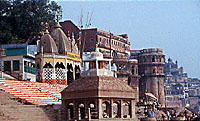 While sitting on the Assi Ghat, several
college age Hindu boys came up to me to
talk to me about America, which I find
amusing and very enjoyable. They are
metallurgy students, but as soon as they
found out that I was in software, they
had a million questions, as they were
considering changing their major to
computer software, since that's where
bigger money is. I told them what a
beginning software engineer makes in
America, which perked their interest,
and gave them a little guidance as to
what kinds of courses to take to boost
their employment chances. God, to them,
lives in a green card, the magic ticket
to the US, in the form of a work visa.
While sitting on the Assi Ghat, several
college age Hindu boys came up to me to
talk to me about America, which I find
amusing and very enjoyable. They are
metallurgy students, but as soon as they
found out that I was in software, they
had a million questions, as they were
considering changing their major to
computer software, since that's where
bigger money is. I told them what a
beginning software engineer makes in
America, which perked their interest,
and gave them a little guidance as to
what kinds of courses to take to boost
their employment chances. God, to them,
lives in a green card, the magic ticket
to the US, in the form of a work visa.
November 7
Heard from my wife Annie about the election results in the US, and that Newt Gingrich resigned as speaker of the house. Boy, the Clinton haters must be seething frustration underneath their all consuming hatred. Breaks my heart.
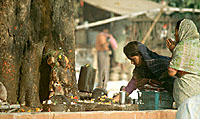 It takes a great will and effort these days
to actually do anything - not because it
is so hot, it cooled down today, but because
I've fallen into the general psyche of the
Hindu subcontinent. Took a bicycle riskshaw
from one end of Varanasi to another, a truly
fun but nerve wracking experience, to pick
up my airt ticket back to Delhi, before a
jaunt into the desert cities of Rajasthan,
and finally Bombay/Mumbai.
It takes a great will and effort these days
to actually do anything - not because it
is so hot, it cooled down today, but because
I've fallen into the general psyche of the
Hindu subcontinent. Took a bicycle riskshaw
from one end of Varanasi to another, a truly
fun but nerve wracking experience, to pick
up my airt ticket back to Delhi, before a
jaunt into the desert cities of Rajasthan,
and finally Bombay/Mumbai.
After an afternoon nap, took a one way boat ride to the ManiKarnika ghat, the most famous "burning" ghat of India, where people have their loved ones bodies burned, giving them a chance for freedom from the rounds of birth and death. It takes over 200 kilograms of wood to burn a body sufficiently, which you might imagine, is a lot of wood, and somewhere in India, there is major deforestation going on for this service. Fees for burning are sliding scale, based on wealth, but the poorest of India cannot even afford the 1000 rupess for the cheapest funeral pyre, so they throw the body into the Ganges. The day before we passed by a bloated yellow body floating near the main ghat; nearby people are bathing, brushing their teeth with Ganges water. Amazing. Reminds me of the famous line in Apocolypse Now, paraphrased, "The Hygiene, The Hygiene...".
After being dropped off, a 30 minute private boat ride (by far the most wonderful way to get around Varanasi), for 60 rupees, ($1.50 USD), I ventured into "Old Town" Varanasi, Gaudalia, built before cars, buses, bicycles and even before horses apparently - the streets, rather alleyways are a claustrophobic nightmare, all but blocked from daylight, and very disorienting at first. My goal was to reach the Viswanath Temple, The "Golden Temple" of Lord Shiva, considering if not The Most, then one of The most sacred temples in Hinduism. So sacred that non-Indians are not allowed in the temple, and can only look from nearby roofs of buildings.
Which is what I did, looking at the 300 kilograms of gold plated roof of the temple. The Indian army is all around, reacting to the threats of radical groups to blow it up. My first look at an AK-47 close up. After my rooftop look, being led by an impromptu 8 year old guide (that I paid off with a 5 rupee note), I decided to get closer to the temple.
After finding the correct alleyway, I went right to the temple doors and looked in, and in a matter of a few moments, there was someone there to tell me to get lost. But I didn't mind that much, I could feel the intensity of the place as I approached it.
But just down the alleyway is the Annapurna Bhavani Goddess temple, dedicated to the Great Mother, and I was allowed in this one, and meditated for awhile. In contrast to other Goddess temples, where the goddess is wielding a sword, truncheon or trident, this godddes is holding a cooking pot, to symbolize the nurturance of the goddess (and of course, the ultimate good mama cook). Unfortunately I couldn't take pictures of either temple on the chance of being on the receiving end of an AK-47 round. Very sensitive area, which gets amplified by the temple energy.
Nearby was a temple dedicated to the little god Sani, which we all know as the planet Saturn. Hindus worship Sani, the maker of obstacles and obsfuscations and delays. By worshipping Saturn, through a particular mantra, of by making offerings here at the temple, the effects of Saturn can be lessened, though, as one who has studied Vedic Astrology, Saturn is always getting a bum wrap - it is a planet that yields great and lasting wisdom, by the mere fact that things are delayed and wisdom gained over time is earned for good. And the famous Indologist and Ayurvedic researcher Robert Svoboda published a book called "the Greatness of Saturn". I'm saying this because I have a big Saturn influence in my chart, and those who do life really begins at 40, as the saying goes.
Another goal was to research shivalingams, an icon representing the masculine force of spirituality in the form of a concical rock symbolizing the human penis. It fits in a "yoni", symbolizing female genitalia, and thus completes the pairs of opposites, generating the creative force of the world. A friend of mine has a really nice 6 inch or so shivalingam, and I wanted to get something like that, but there's no way I could carry such a heavy rock for the rest of my trip, so I bought a 3 inch lingam, and now I have lingam envy.
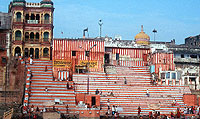 Caught a boat back to my Ghat area, but
the trip south is really difficult, since
the surface of the Ganges flows north (even though
the current below the surface flows south -
another mystery of the Holy Ganges River).
The boatguy really worked and worked, so
much so that his oar broke within a mile
of my destination, so we pulled over and
I walked the rest of the way through all
kinds of dark alleyways, till I reached
the main street, and back home. It's
amazing how quickly one adapts, resulting
in a feeling of comfort and familiarity.
Caught a boat back to my Ghat area, but
the trip south is really difficult, since
the surface of the Ganges flows north (even though
the current below the surface flows south -
another mystery of the Holy Ganges River).
The boatguy really worked and worked, so
much so that his oar broke within a mile
of my destination, so we pulled over and
I walked the rest of the way through all
kinds of dark alleyways, till I reached
the main street, and back home. It's
amazing how quickly one adapts, resulting
in a feeling of comfort and familiarity.
But again, the feeling is one of total safety, especially since just about every ten feet or so there's a temple - it would take years to investigate every one. They are practically stacked on top of each other here.
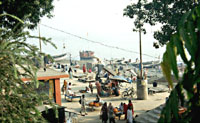 So again I hung for awhile at the Assi Ghat
amidst the several Shiva temples, Hanuman
temples, sacred tree with lingam and one
crazy man in a cool turban, who sits in
one spot all day and occasionally has an
argument with someone or something unseen.
Tonite we had the added attraction of a
mad cow rampaging up the steps of the ghat,
clearing people in a hurry, including me.
Around 6pm everyone gets chai in these
small clay cups which are then discarded
on the ground and instantly cracked into
several pieces, probably made of clay of
the Ganges mud.
So again I hung for awhile at the Assi Ghat
amidst the several Shiva temples, Hanuman
temples, sacred tree with lingam and one
crazy man in a cool turban, who sits in
one spot all day and occasionally has an
argument with someone or something unseen.
Tonite we had the added attraction of a
mad cow rampaging up the steps of the ghat,
clearing people in a hurry, including me.
Around 6pm everyone gets chai in these
small clay cups which are then discarded
on the ground and instantly cracked into
several pieces, probably made of clay of
the Ganges mud.
If I haven't mentioned it before, the Hotel Ganges View has great dinners every night, which is always a great way to meet people. So another Traveller's Note:
 If you go to Varanasi, I recommend
the 3 places mentioned previously
in this report. They are cheap,
clean and comfortable, and the Assi
Ghat area is far enough away from the
noise of central Varanasi to be
a great spot for retreat or relaxed
hanging. I really enjoy this area.
The Cantonment area, in the opposite
side of town, is nice also, with
a lot of shady streets, but that
is a place for the big and expensive
hotels. So there's a suitable place
for any budget. Oh God, I'm starting
to sound like a travel agent. I
better stop now.
If you go to Varanasi, I recommend
the 3 places mentioned previously
in this report. They are cheap,
clean and comfortable, and the Assi
Ghat area is far enough away from the
noise of central Varanasi to be
a great spot for retreat or relaxed
hanging. I really enjoy this area.
The Cantonment area, in the opposite
side of town, is nice also, with
a lot of shady streets, but that
is a place for the big and expensive
hotels. So there's a suitable place
for any budget. Oh God, I'm starting
to sound like a travel agent. I
better stop now.
November 8
Awoke this morning to a woman entering my room, mistaking me for her business partner. But slept for 9 hours and feel laid back. The plan was to go back to the Old City of Varanasi and see new things, revisit other places seen yesterday.
Met with Deepak, a boat wallah who glommed onto me, but offers decent tourist ripoff prices.
The Nepali Temple
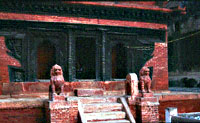 My first stop was the Nepali temple in
the Old City, a temple distinct in its
architecture, looking more like a East
Asian Pagoda than anything else. Like
its big cousin it Khajuraho, it is famous
not only for its architecture, but for
the erotic wooden sculptures built into
the external columns and facades. I met
the temple priest/hustler who instantly
becomes my best friend, meaning that he's
gonna want some big donation later.
My first stop was the Nepali temple in
the Old City, a temple distinct in its
architecture, looking more like a East
Asian Pagoda than anything else. Like
its big cousin it Khajuraho, it is famous
not only for its architecture, but for
the erotic wooden sculptures built into
the external columns and facades. I met
the temple priest/hustler who instantly
becomes my best friend, meaning that he's
gonna want some big donation later.
 He gives me the history of the temple
and says that he's the 7th generation
of a family that has been serving the
temple. The temple sits right off the
Ganges on a small crowded hill, and
one approaches the temple passing
two dragon-dogs, like in Ghostbusters.
The inner sanctum is impressive, a
very large Shivalingam, with a brass
pot overhead that drips water from the
Ganges slowly all day, keeping the
lingam moist, and creating holy water.
Despite the annoyance of the temple
priest, I am surprisingly affected
by a presence around the temple, and
feel "blessed" by it. The erotic scupltures
are X-rated, but not grossly so, depicting
oral sex, masturbation, and various sexual
positions only someone adept in yoga could
possibly perform. Now that is the reason
why people do yoga! There is one set of
carvings of oral sex on a table or a desk
that could only been Bill Clinton and
Monica Lewinsky in a previous life.
He gives me the history of the temple
and says that he's the 7th generation
of a family that has been serving the
temple. The temple sits right off the
Ganges on a small crowded hill, and
one approaches the temple passing
two dragon-dogs, like in Ghostbusters.
The inner sanctum is impressive, a
very large Shivalingam, with a brass
pot overhead that drips water from the
Ganges slowly all day, keeping the
lingam moist, and creating holy water.
Despite the annoyance of the temple
priest, I am surprisingly affected
by a presence around the temple, and
feel "blessed" by it. The erotic scupltures
are X-rated, but not grossly so, depicting
oral sex, masturbation, and various sexual
positions only someone adept in yoga could
possibly perform. Now that is the reason
why people do yoga! There is one set of
carvings of oral sex on a table or a desk
that could only been Bill Clinton and
Monica Lewinsky in a previous life.
Viswanath Golden Temple
From there I revisited the original Viswanath Golden Temple, and really can feel the presence of the temple as I approach it, which doesn't disappoint, despite the fact I cannot go inside. The inner temple grounds are painted in a faint light purple leading to the inner chamber which cannot be seen from the large metal door entrance. You can feel the intensity grow in the little alleyway that provides access to the front entrance the closer you get to it. It is definitely worth the effort to get to see, if only a peeks worth. Actually I do know one American that got into this temple, which I find amazing...I guess Lord Shiva works in mysterious ways, my son, sometimes.
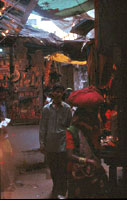 I cannot completely describe the level
of filth that exists in the Old City,
a place without adequate sewage facilities,
and chock full of piles of cow dung.
This is the kind of place where major
diseases fester, and it is a tribute
to the immune system of the natives that
they aren't all sick. You actually have
to work to find a relatively clean spot
to stop and sit down, one where there
is no shit, urine, human spit, sewage
water or rotting garbage. It is truly
astounding, and not to mention a bit
smelly on this unusually hot, humid
November day. I'd love to parachute
Jerry Seinfeld in here and watch him
freak.
I cannot completely describe the level
of filth that exists in the Old City,
a place without adequate sewage facilities,
and chock full of piles of cow dung.
This is the kind of place where major
diseases fester, and it is a tribute
to the immune system of the natives that
they aren't all sick. You actually have
to work to find a relatively clean spot
to stop and sit down, one where there
is no shit, urine, human spit, sewage
water or rotting garbage. It is truly
astounding, and not to mention a bit
smelly on this unusually hot, humid
November day. I'd love to parachute
Jerry Seinfeld in here and watch him
freak.
I am both annoyed by all the touts and shopkeepers trying to lure me into their stores or to become their guide (and have to give some my mean and nasty look with pointed fingers to get through to them), and very charged by the potency of the temples that I have visited. Passed by the Sani/Saturn and Annapurne temple which is on the same alleyway as the Golden temple. In fact, I pass the Golden temple several times in my traversing the human rat-maze of the Old City of Goudalia, just for the blessing.
The Rough Guide mentions that there is another Viswanath temple in the Old City (in addition to the more famous "New Viswanath Temple" in south Varanasi, on the University campus). This intrigues me, and perhaps I can go inside to this temple. I ask an Indian army soldier where the temple is and if I can go inside, and she says no, I am not allowed. But let's see what happens.
Traveller Note: I am finding that The Rough Guide is an invaluable companion to the Lonely Planet, and contains information that is not mentioned in her more famous companion book. I highly recommend carrying both, since you will get specific information not found in the other, and can verify good hotels and restaurants mentioned in both...if you can handle the weight of these two very thick paperbacks. The Rough Guide is definitely more hip, Lonely Planet more conventional. There is also the India Handbook, which I don't know anything about.
New Viswanath Temple
Not very well known, and only mentioned in The Rough Guide, the New Viswanath Temple of the Old City was built apparently by a conservative bunch of sadhus when a few "untouchables" entered the Golden Temple early this century. Talk about picky! So this second temple was built, and since it was built by more conservative brahmans, I figured I would not have any chance of being let in. But to my surprise, approaching the steps, and making a request gesture to come in, someone a the top of the steps says ok, and I go in.
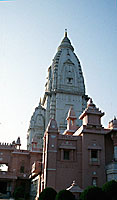 Like most temples, there is a large marble
or other well polished stone floor, and
in the center is a small chamber containing
the shivalingam. I quickly approach the
inner chamber, which everyone except the
temple priest is barred from, and gaze
at the huge shivalingam. The priest is
giving the lingam a major bath of Ganges
water from a huge metal pot. I get a
lot of major,"what the hell are you
doing here?" gazes from the gang of
sadhus and worshippers in the temple.
Like most temples, there is a large marble
or other well polished stone floor, and
in the center is a small chamber containing
the shivalingam. I quickly approach the
inner chamber, which everyone except the
temple priest is barred from, and gaze
at the huge shivalingam. The priest is
giving the lingam a major bath of Ganges
water from a huge metal pot. I get a
lot of major,"what the hell are you
doing here?" gazes from the gang of
sadhus and worshippers in the temple.
I stay at the inner chamber railing, containing a small altar with a cobra icon, for a while, which always seems to surprise or annoy the temple priests, like I'm stealing something, or getting too much of the show. But too bad! As I move away, I go towards the table containing ash and kum-kum, the red substance that Hindus put on their forehead, sometimes called a "teelak". I forgot the procedure, and use the middle finger of my right hand to apply the substances, and a priest is right there to correct me, to use the ring finger for application. Makes me feel a little stupid. Feeling a bit more emboldened in this very intense atmosphere, I walk up to the replacement priest at the top of the stairs to ask a question, and he gives me a major vibe and head gesture, which translated would be "get the hell outa here, white boy!". Ok, ok, you pissy old sadhu. So I leave, and maybe that was just luck to get in or maybe it is open to all, I'm not sure, but I'll certainly remember the place.
Jnana Vapi and Mosque
Jnana Vapi literally means "wisdom well", a well right next to the Golden Temple where it is described that Lord Shiva cooled off his lingam (it didn't say what he was doing with it to make it so hot!), and thus created a well whose water is said to be liquid wisdom. Unfortunately, the priest had to put a covering over the well, as some people were trying to off themselves in one huge leap for moksha/liberation, and to prevent the contamination by coins. (Isn't it interesting that the throwing of coins into a well or standing body of water is a universal custom?).
But nevertheless it is a wonderful temple complex, very spacious in comparison of the crampness of the Old City. One one side is the Golden Temple, and the other side is teh Jnana Vapi Mosque, which is actually the original site of the Golden Temple. However there was one Moghul butcher/emperor named Aurangzeb (the son of Shah Jahan, the creator of the Taj Mahal), who, when conquering Northern India, would destroy the Hindu temple and place a mosque right on top of the site. So you can imagine how old and deep the hostilities between Hindu and Muslim must go, knowing that a mosque is right on top of your Hindu holy site. And because of that, the mosque has incredible security, barbed wire, several fences, metal detectors, video cameras all over the place. But no one checks my big backpack - being an American, no one thinks that I could be carrying 50 pounds of C-4, which would blow up a major chunk of the Old City. It seems like a security breach to me.
So I circumambulate the well, brushing off the self-appointed guides and shoe guy who eventually will want a donation - as in the the line in the Dead song "Trucking" - "the just won't let you beee, oho no". The well is 6 foot in diameter, and is a real beautiful place and has a presence. Once completing a circumambulation, I go to the temple priest, who talks me into a personal puja for 100 rupees, for a long life for me and my family - it seems so tacky, but hey, what's two bucks?
As part of the puja, I am to drink three offerings of well water from the priest - ordinarily when I receive holy water to drink from a priest, such as every night on the Assi Ghat after Gangarati, I always fake the drink to the mouth and pour it over my head, knowing that the water is coming from the bacteria-festering Ganges river. And I notice many other westerners doing the same. But this water, I take in, and it tastes clean and refreshing on this hot day. So I get my long life puja, and find my way through the Old City, past cow and dog and shit and stench and sewage and tout and guide and heat to the Manikarnika Ghat, the burning ghat, where bodies are burned for hopeful liberation.
The Manaikarnika Burning Ghat
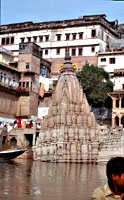 This ghat is right next to the
"sunken temple" ghat, one where
the engineering wasn't topnotch,
and it sunk into the Ganges, and
now only the spire appears above
the water (reminds of that one
college library where the engineers
didn't take into consideration
the weight of the library books,
and is now sinking slowly into
the ground).
This ghat is right next to the
"sunken temple" ghat, one where
the engineering wasn't topnotch,
and it sunk into the Ganges, and
now only the spire appears above
the water (reminds of that one
college library where the engineers
didn't take into consideration
the weight of the library books,
and is now sinking slowly into
the ground).
The Manikarnika ghat is adorned with huge piles of wood, of varying quality, all the way to sandalwood, for the funerals of the wealthy. Like the good Tantrik that I am, I figure that I'll hang here for awhile, like the guys who meditate in the graveyards at night. (Well, ok, it's daytime, but it's the only chance I'll get to be here).
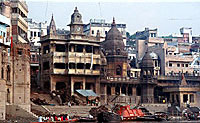 As I said before, the energy here
is different than the rest of the
ghats, and for obvious reasons. And
the only demons that I encounter
are the incessant touts and guides
who annoy the daylights out of me
to the point of wanting to punch
one. So this is how the dark forces
maifest here, in these assholes.
One guy, a shaven head one indicating
a worker here, works at the hospice
next door and keeps asking for
a bigger donation. Finally I literally
shush him 5 times before he gets the
message and leaves. So I brazenly work
my way to the area where four funerals
are occurring in various stages.
As I said before, the energy here
is different than the rest of the
ghats, and for obvious reasons. And
the only demons that I encounter
are the incessant touts and guides
who annoy the daylights out of me
to the point of wanting to punch
one. So this is how the dark forces
maifest here, in these assholes.
One guy, a shaven head one indicating
a worker here, works at the hospice
next door and keeps asking for
a bigger donation. Finally I literally
shush him 5 times before he gets the
message and leaves. So I brazenly work
my way to the area where four funerals
are occurring in various stages.
The burning body closest to me is about half burned. I can't recall being so close to a decomposed body and it reminds me of the scene from a concentration camp movie. But there really is no reaction in me to the body at all, it's just another thing, watch it burn, skin all gone, mostly charred skull and major bones. The hospice guys says that the two hundred kilograms of wood needed to burn a body still does not completely burn the big bones, like the skull, hip bones, and femur, and they along with the ashes, are thrown into the Ganges.
The next funeral pyre is just being prepared for burning, an old woman wrapped in a beautiful sari-like cloth. Hay is placed inside the pyre and the priest circumambulates the pyre three times with a torch of burning hay in the hot burning sun. He then lights the hay in the center of the pyre, and it goes up in flame. He throws some kind of brown powder onto the pyre, don't know what it is. In the furthes pyre, the family is carrying the dead body, wrapped in cloth and colorful wraps, through the alleyways and into the Ganges for a final dip. It is important that water goes into the mouth of the dead body to symbolize the last drink from the Ganges. Then the body is placed onto the pyre and more wood is stacked around it. The elder male of the family shaves his head as part of the funeral ceremony.
I was able to watch this endless procession of funerals and burning for about 15 minutes in the heat of the midday sun. There was no awful smell, in fact, it was a helluva better then the festering sewage heap of the old city. When the smoke did come my way there was only a touch of burning tissue, mostly wood (no, I am not getting off on this, believe me, just reporting the facts, ma'am). Finally someone came over to me and asked me to leave, as the place I was standing was for the families, and then he asked for a donation. AAAAAaaaghhh!
On the way to the main Ghat, the Dasaswamedh ghat (the ten horse sacrifice ghat), I checked out a 6 inch crystal shivalingam for only 400 bucks - sooo tempted, but too heavy.
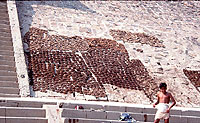 So back to my hotel, pass the
numerous ghats along the way
on this wonderful boat ride.
One ghat is filled with circular
piles of cow dung, drying in the
sun, to be used for cooking fuel,
and in other ghats, color sheets
and saris dry among the the steps
after their pounding in the
Ganges by the dobiwallah laundry
sadists, making particularly good
Kodak moments.
So back to my hotel, pass the
numerous ghats along the way
on this wonderful boat ride.
One ghat is filled with circular
piles of cow dung, drying in the
sun, to be used for cooking fuel,
and in other ghats, color sheets
and saris dry among the the steps
after their pounding in the
Ganges by the dobiwallah laundry
sadists, making particularly good
Kodak moments.
A good shower and lunch at the Hotel Temple on the Ganges (take lunch on the roof for an incredible view of Varanasi, but in the shade!), and this ends my last full day in Varanasi, a place that held onto me and wouldn't let me go.
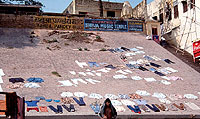 If you ever come to India, you must
come to Varanasi, and boat and walk
among the ghats. Simply existing in
Varanasi is meditation, at least
along the ghats, where Shiva is to
be found most readily. I feel really
in synch with India now, despite being
white boy with money, and a moving
target for touts. I am settled in and
now ready for a tour of Rajasthan,
via my last stand in the pollution
of Delhi. Wish my lungs luck, please!
If you ever come to India, you must
come to Varanasi, and boat and walk
among the ghats. Simply existing in
Varanasi is meditation, at least
along the ghats, where Shiva is to
be found most readily. I feel really
in synch with India now, despite being
white boy with money, and a moving
target for touts. I am settled in and
now ready for a tour of Rajasthan,
via my last stand in the pollution
of Delhi. Wish my lungs luck, please!
 Back |
 Delhi, Once Again... |
|
|
Page 12. |
||
